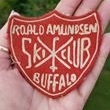|
|
Source: SnowJournal - xskier
SJ Thread
Note: Most data was used without corroboration. Please send any corrections, comments or feedback: to: Joshua Segal
Drive out Rt.240, through Orchard Park. Veer off onto Chestnut Ridge Rd. and straight ahead was Chestnut Ridge Park.
|
|
Chestnut Ridge Park.had a gas powered rope tow , slope either side, lights for night skiing and all free!
|
|
Further out of town before the hard right turn is the Cole Rd. which takes you up to the Lower East Hill Rd. where the 3 original private ski clubs were;
Matterhorn, Sitzmarker and the Buffalo Ski Club, all in a row on the left side of the Rd. (east exposure).Parking/warming hut (clubhouses) were
at the top of the hill: ski down ride up. Each had a rope tow and one or two of them had T-bars. Buffalo Ski Club still exists and the other two are combined
to form what is Tamarack Ridge today;(open to the public).
|
|
Back down on Rt. 240, heading south and just before West Falls, Ny. was a small clearing (rectangular) up from road on the left hand side adjacent to an
older house. This was the owners private property and was probably never open to the public.
"Think Snow " was a slogan they painted onto the rope tow power shack. This short little hill had a western exposure.
|
|
Continuing on Rt. 240 you will find Crump Rd. on your left just inside the town of Glenwood. Bob Chrone (original founder/builder of
Glenwood Acres) owned some land up Crump Rd.(west exposure) and cleared a slope to become the Glenwood Acres Ski Club. In later years
he developed what became Glenwood Acres on the right side of Rt.240(T-bar and rope tow) (then two t-bars) ( east exposure) --- now
known as Kissing Bridge North.
|
|
To the exteme right of old Glenwood Acres was Murray Hill Ski Club, now Colden Tubing Hill . In the early sixties there was a small warming hut/chalet off to the left of the base area for the Glenwood Acres Ski Club.
|
|
Located on a hillside east of 240, just north of Killer curve. It operated in the 1960s.
The area was named after "Roald Amundson", a Norwegian Explorer, who was the first to cross through the northwest passage. The ski area had a small rope tow and the train use to stop there dropping off people to ski. Unfortunately it was on the wrong side of the valley and was too sunny to keep the snow. Eventually its members split up and moved on to Murray Hill Ski Club as well as Glenwood Acres.

Info supplied by Ludwig Heimrath. Jan. 2020
|
|
Just beyond Glenwood Acres. on the same ridge , Kissing Bridge was built by Robert James. Both these areas could only be accessed by crossing bridges over the west branch of Cazenovia Creek. Kissing Bridge was named with the intent of building a covered bridge.
|
|
Just beyond Kissing Bridge (same ridge) was Concord Ski Club ( Kissing Bridge's private ski club) with one T-bar and possibly a rope tow. Of course we all know this whole ridge now as the Kissing Bridge Corporation under the directorship of Mark Halter. Mark was one of the original members of the West Seneca Ski Club (Shneeflocken - Snowflake).
POVERTY HILL
OLYMPUS ONE
SNOW MT.
|
Snow Mountain was located on the Poverty Hill Rd., off the Lindbergh Rd., which is all off U.S.219;
Ellicottville, N.Y. The property was originally built as Poverty Hill Ski Area (opening in +/ - 1967).
Years of operation unknown to me. Robert Lambo of Hamilton, Ont. Canada bought Snow Mountain in 1975.
T-bar and 'Pony' lift were the uphill service.
GROSTAL
SKI WING
WING HOLLOW
|
Grosstal, W. Five Mile Rd. Allegany, N.Y., opened in 1963. Lots of problems and setbacks during
its existence. Financial problems, chairlift accident-1968, bankruptcy-1969,1970-new owners
changed the name to Wing Hollow then on to Ski Wing. The Exchange Bank Of Olean took over in 1974
and leased the place to Ohio interest. Two slope groomers were murdered in 1978, walking in on a
late night safe heist that lead a lot of people to believe that it was an 'inside job'. Snow quantity
and slope conditions were never ideal to today's standards.
BACK TO OPERATIONS
